Growing Blog
Understanding Mushroom Substrates
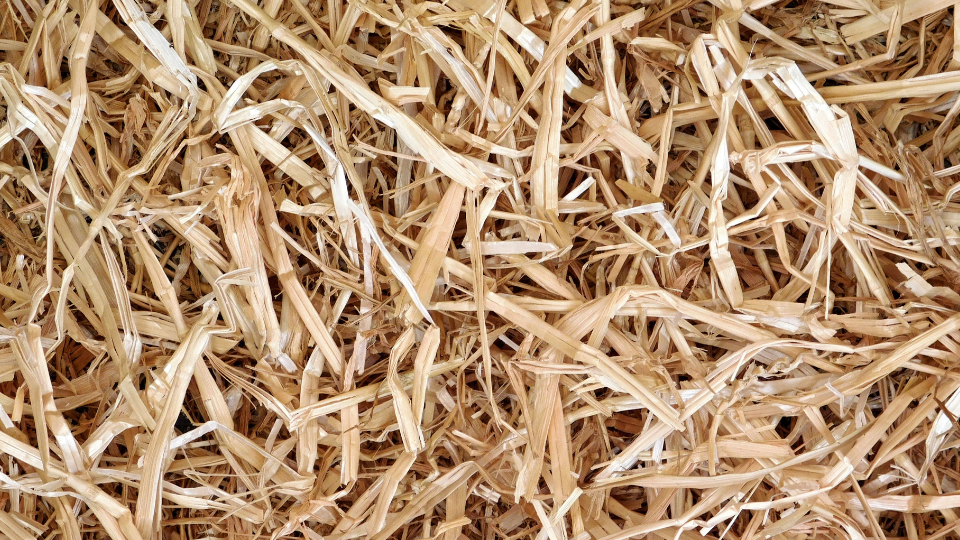
Contents
- Common Mushroom Substrates
- What is a Mushroom Substrate?
- Pasteurizing or Sterilizing the Substrate
- Water in the Substrate
- Different Substrates for Different Mushrooms
- Using Straw as a Substrate
- Using Hardwood Sawdust and Chips
- Supplementation
- The Masters Mix
- Growing Mushrooms on Manure
- Growing Mushrooms on Coco-Coir
- Growing Mushrooms on Coffee
- Uses for Spent Mushroom Substrate
- Learn What Works for You
Finding the perfect mushroom substrate for your grow- and getting the right substrate recipe– is one of the most important aspects of mushroom cultivation.
New growers will quickly realize that growing mushrooms is significantly different than growing plants.
Although the concept of a mushroom substrate can be thought of as somewhat analogous to the soil for a plant, the way that mushrooms actually use a substrate is different, and needs to be fully understood by the cultivator in order to achieve the best results.
Common Mushroom Substrates
Pasteurized Straw is commonly used to grow oyster mushrooms. It is cheap and effective, albeit a little messy.
Hardwoods such as oak, beech and maple make for a great substrate for many types of mushrooms, especially when combined with a bran supplement.
Soy hulls can be mixed with hardwood sawdust at different ratios to produce extremely effective and high yielding substrates, particularly for growing oysters.
Common button mushrooms are grown on composted manure, specially prepared using a two phase composting and sterilization process.
Coir is a commercially available mix of ground up coconut husk and shells which can be mixed with vermiculite to create an effective substrate.
Mushrooms will grow on a number of urban and agricultural waste products, from spent coffee grounds to banana leaves.
What is a Mushroom Substrate?
To put it simply, a substrate is a bulk material that the mushroom mycelium can use for energy and nutrition. A good substrate is required in order for the mushroom to grow and to fruit.
Common substrate recipes for growing mushrooms usually involve straw or hardwood sawdust, although there are many other good options to be considered.
The mushroom substrate needs to be properly prepared by adding water, potentially adding additional nutrition, and further processed by sterilization or pasteurization. When ready, it can be “Innoculated”, wherein broken up pieces of mycelium-covered grain, also known as grain spawn, are evenly mixed into the substrate.
Under the right conditions, the mycelium will start to grow, rapidly devouring and decomposing the organic material in a process known as “colonization.”
The mushrooms are ready to fruit once the substrate is fully colonized- meaning it has been completely consolidated and encompassed by the mycelium.
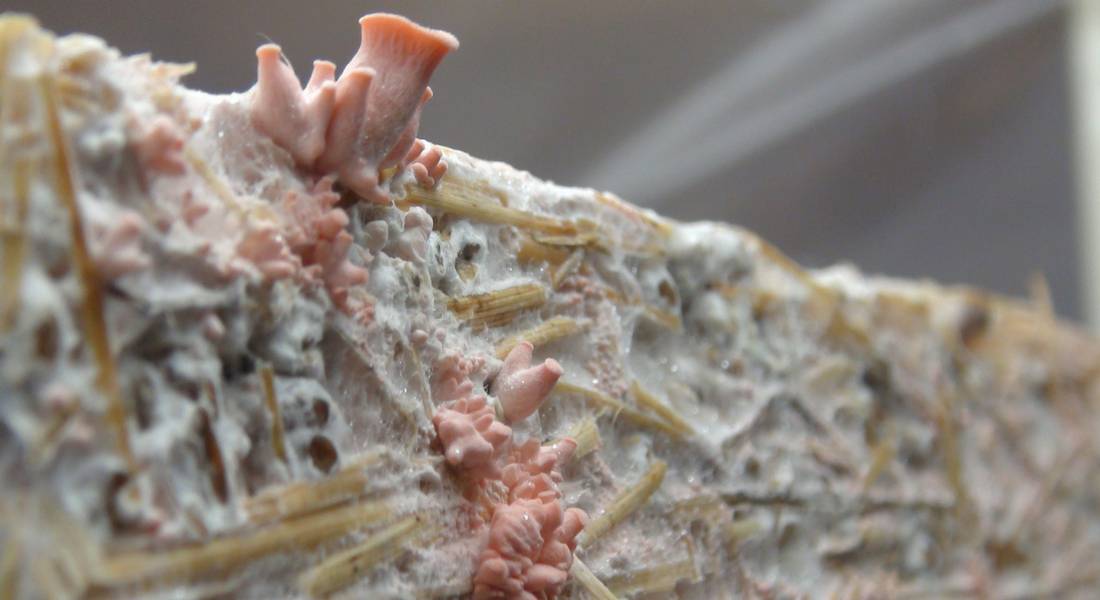
Pink Oysters Pinning on a Fully Colonized Straw Based Substrate.
Pasteurizing or Sterilizing the Substrate
Ideal mushroom substrates are moist and full of nutrition. Unfortunately, there are many other things that also thrive in these conditions, such as molds and bacteria. These contaminants can grow much faster than the mushroom mycelium, so something needs to be done in order to give the mushroom an advantage in the race to colonize the substrate.
This can be accomplished by the process of sterilization or pasteurization.
Pasteurization is the process of heating up a substrate between 150-180 deg F for a period of 1.5-2 hours. It doesn’t remove all the contaminants, but it will reduce the overall population of other microbes to a level that gives the mushroom species a head start.
Some microorganisms will survive pasteurization and remain in the substrate in some capacity, but can actually helpful for the growth of the mushroom in the long run.
PASTEURIZATION:
The process of heating a bulk substrate between 150 – 185 deg F with steam or in a hot water bath in order to reduce the overall level of contaminates and give the mushroom culture a head start.
STERILIZATION;
The process of heating the substrate to extreme temperatures exceeding 250 deg F, under pressure, in an attempt to completely eliminate any living or dormant contaminants within the substrate.
So what kind of substrates are pasteurized?
One perfect examples is non-supplemented straw, a mushroom substrate which is nutritious enough for the mushrooms to grow, but not so rich in nutrients that it needs to be fully sterilized.
Pasteurization can be achieved either by subjecting the straw to steam injection or by soaking the straw in a hot water bath. Both methods serve to pasteurize and moisten the straw. After it is cooled, the straw can be inoculated with the mushroom culture.
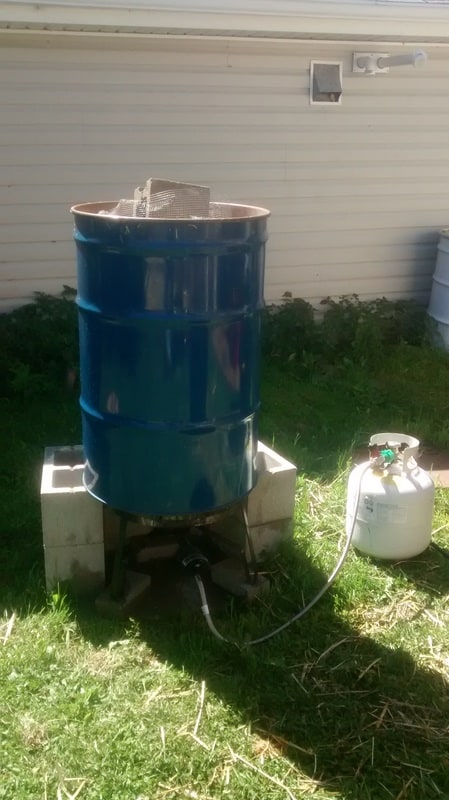
A burner set up for pasteurizing straw.
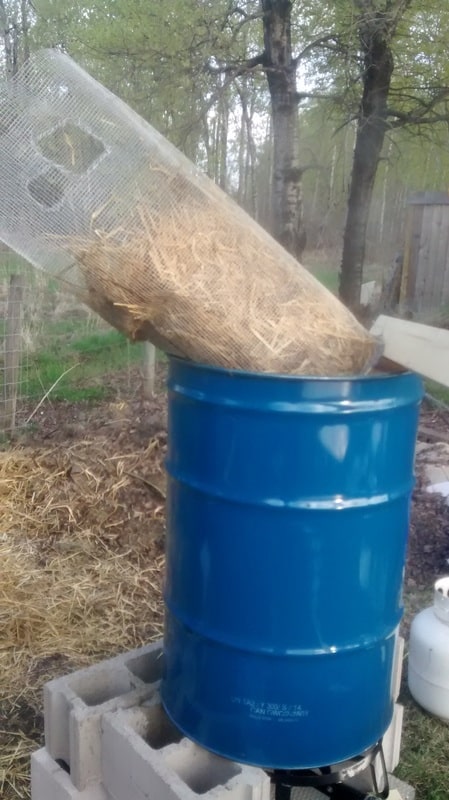
Straw cooling after being pasteurized.
Substrates which are more nutritious, such as supplemented hardwood sawdust, need to be sterilized rather than pasteurized. If not sterilized, the substrate will almost always contaminate with molds, long before the mushrooms have a chance to fully colonize.
This is usually due to the addition of overly nutritious bran, or other form of supplementation, which allows the molds to quickly claim victory over the substrate.
Sterilization is the attempt to completely eliminate all forms of contamination. This is done by heating the substrate under pressure for an extended period of time. For supplemented sawdust fruiting blocks, typical sterilization protocol is to pressure sterilize at 15 PSI for 2.5 hours.
This brings the temperature of the substrate up to 250 deg F, effectively killing off any potential contaminants.
The substrate then needs to be inoculated under completely sterile conditions, and remain sterile until the mushroom is able fully take hold.
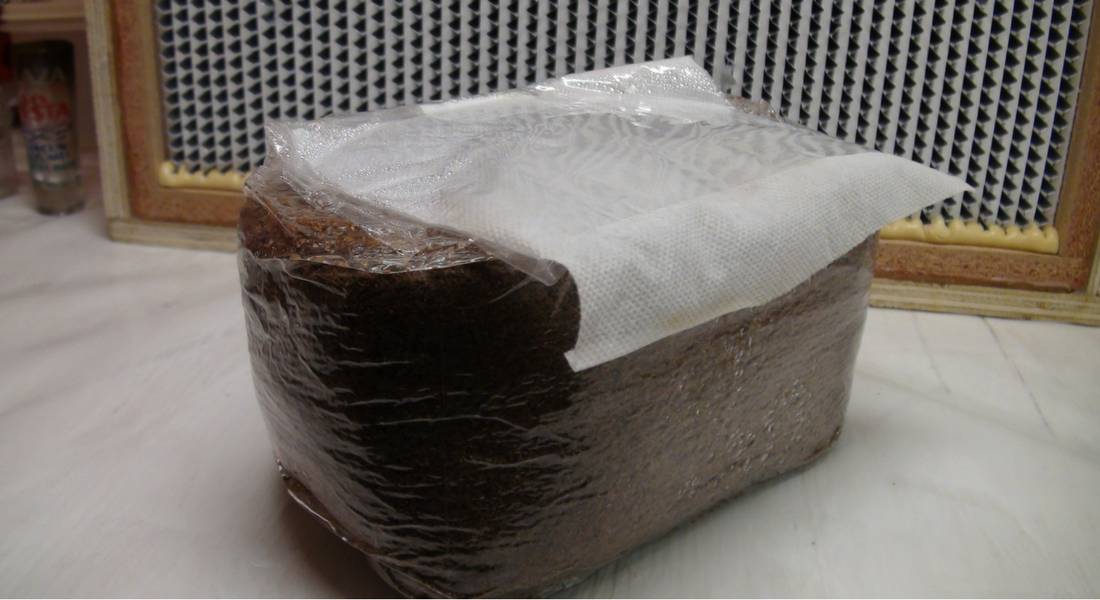
Supplemented hardwood sawdust fruiting block after sterilization and before innoculation.
Water in the Substrate
Mushroom fruiting bodies are 70-90% water, and all of that water is drawn up from the substrate. Unlike plants, mushrooms are not “watered” during the growing cycle.
Of course, humidity needs to be added to the air so that the substrate doesn’t dry out, but all of the water that mushrooms require to grow is added to the substrate before inoculation.
For this reason, the substrate needs to be properly hydrated during preparation. For straw, this typically occurs during the pasteurization process, when the straw is soaked in hot water. For supplemented sawdust fruiting blocks, an appropriate amount of water should be mixed into the sawdust before the sterilization process.
If your substrate is too dry, growth will be slow, and the mushrooms may fail to overtake the substrate at all. On the other hand, if the substrate is too wet, it may encourage bacterial growth and inhibit full colonization. Getting just the right amount of water in your substrates definitely takes some practice.
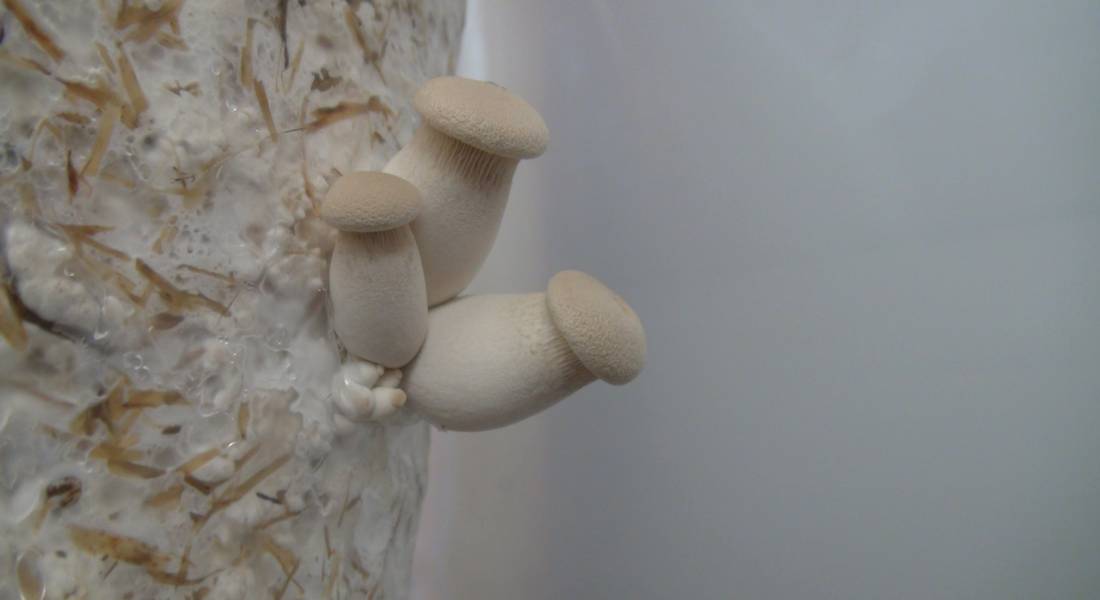
Different Substrates for Different Mushrooms
Different species of mushrooms have different preferences of substrates, although there is definitely some flexibility in what you can use successfully.
Most varieties of oyster mushrooms grow well on straw. This includes Blue Oysters, Pearl Oysters, Yellow Oysters and Pink Oysters. Even King Oysters will grow well on straw, although you can expect a higher yield, and better looking mushrooms if you grow Kings on sawdust instead.
Most other gourmet and medicinal mushrooms grow best on supplemented hardwood sawdust. This includes Reishi, Lions Mane, Maitake and Shiitake.
Oysters will also grow well on hardwood sawdust. A standardized fruiting block recipe will work well for all the species listed here, but it is definitely worth playing around with moisture content and supplementation level to see if slight variations make a difference.
GROW ON STRAW:
- Blue Oysters
- Yellow Oysters
- Pink Oysters
- Pearl Oysters
GROW ON SAWDUST:
- Reishi
- Lions Mane
- Shiitake
- King Oysters
Using Straw as a Substrate
Straw is a cheap and extremely effective substrate that works well for many types of mushroom species. Straw is the stem portion of grains such as wheat, barley or oats – it’s basically what is left over after the grain itself has been removed.
In many ways, straw is an agricultural waste product.
If you live near a farming community, you should have no problem finding straw. A 40lb (dry weight) square bail should cost no more than $2-4. Keep in mind that straw is messy to work with – it needs to be chopped, cleaned and pasteurized before being used as a substrate. It works best for medium to large grow operations which have a separate prep area and a large drum for pasteurization.
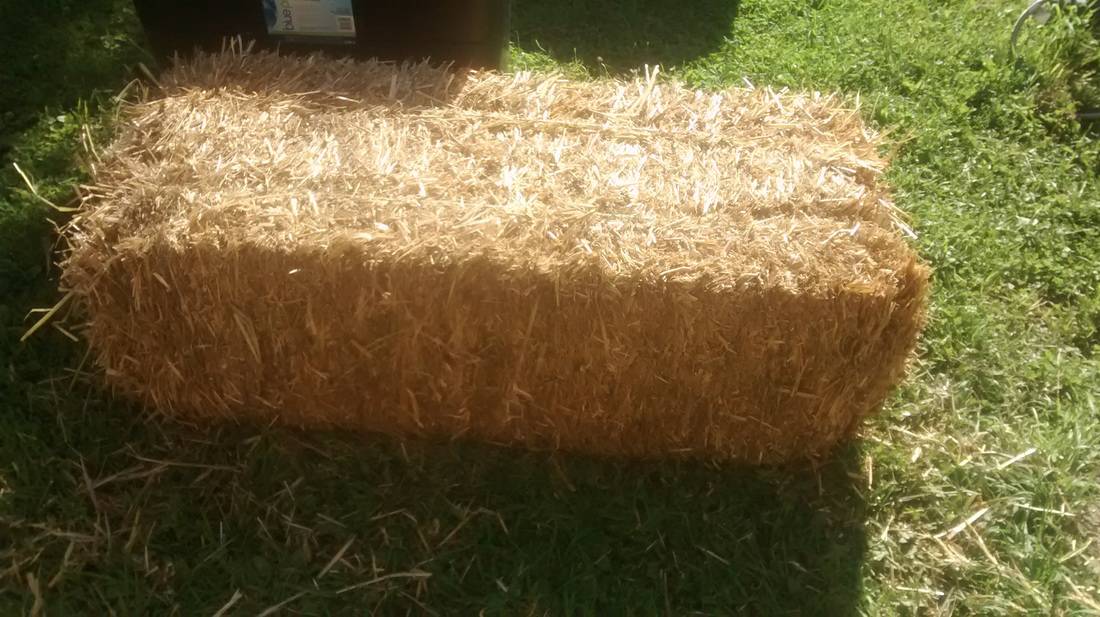
A 40lb square bail of straw, compressed.
That being said, you can still use straw for hobby scale indoor grows. A smaller amount of straw can be chopped with garden shears and pasteurized by pouring hot water into a tote- instead of using a large drum and a gas burner.
If you are planning to do small scale grows using straw, you might want to consider using EZ Straw. This is especially convenient if you don’t live anywhere near a farming community. They sell coarsely cut straw in a convenient bag, already pre-cut and cleaned. Using something like EZ Straw will prevent a lot of the mess and hassle of dealing with large bales of straw.
Using Hardwood Sawdust and Chips
Hardwood sawdust makes for an excellent mushroom substrate, and is commonly used in industry. It is a waste product of the lumber industry, and might be cheap and easy to find, depending on your location.
The fine sawdust is typically mixed with wood chips, which seems to allow for faster colonization of the substrate and provide a better structure for the mycelium to take hold.
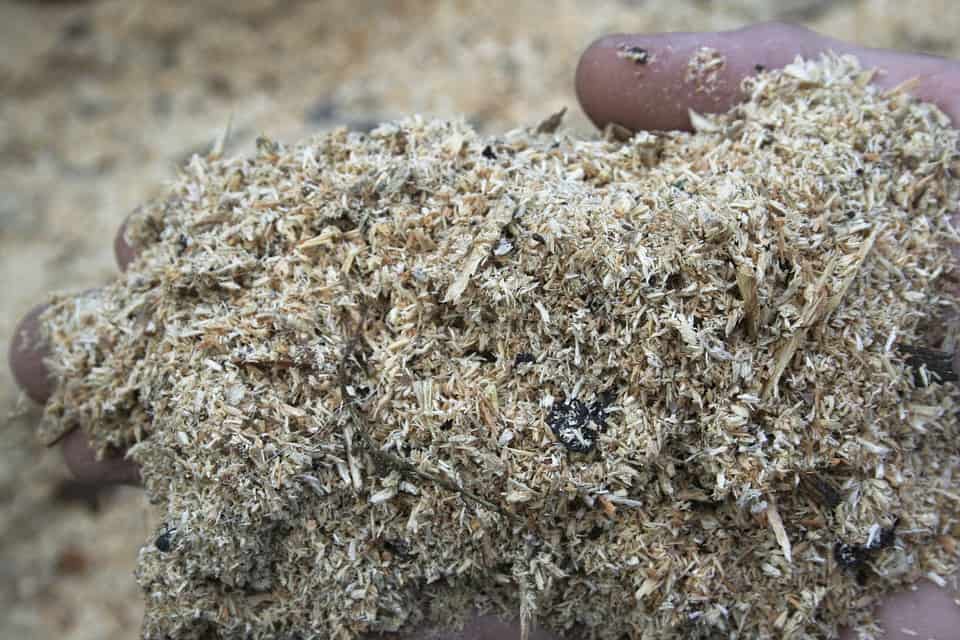
Commonly used hardwoods are oak, maple, beech, and hickory- or a mix of multiple species. Softwoods such as spruce, pine and fir are not suitable for mushroom cultivation.
If you are in an area where you don’t have easy access to hardwood sawdust, you can always use hardwood pellets. These are typically used for wood stoves- but will also work well for growing mushrooms! The pellets need to be soaked in water before being broken up into fine sawdust\. Soaking in water will also serve to hydrate the substrate.
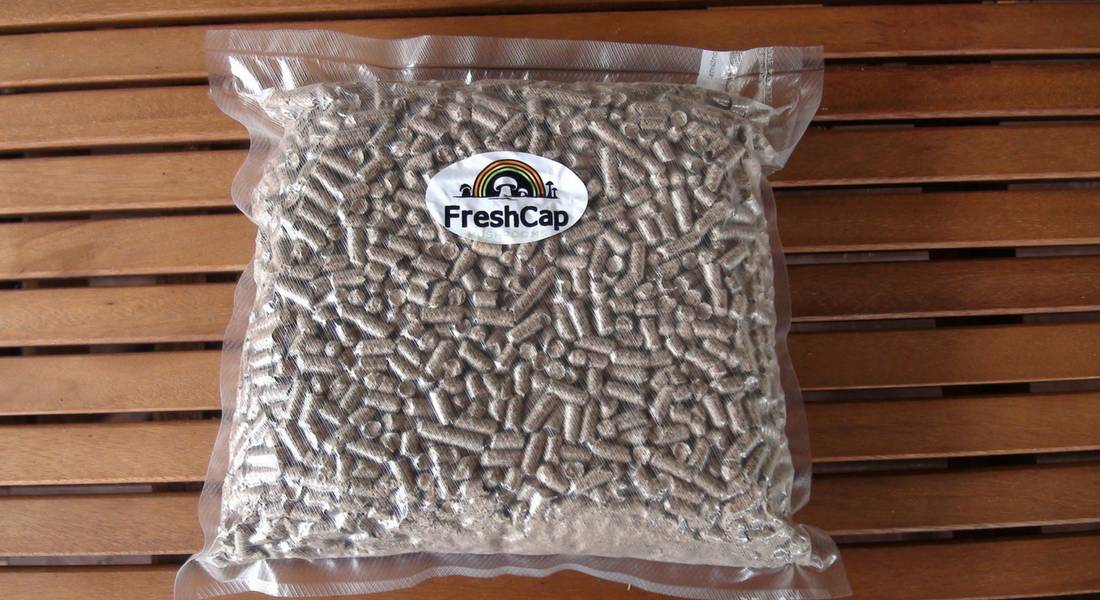
You can usually find the pellets inexpensively, although they may only available seasonally in most retail stores. There is a large selection of them available here.
They usually come in large 40lb bags, which should be enough sawdust for most small scale hobby grows. Again, make sure the pellets are hardwood and not softwood. You also want to make sure that the pellets don’t contain a lot of glues, paints or other additives.
If you are growing mushrooms using sawdust pellets, the following substrate recipe works well for many types of gourmet mushrooms:
For every 5 lb fruiting block:
- 5 cups of hardwood pellets
- 1.4 liters water
- 1-1/4 cups wheat bran
Check out our article on growing mushrooms on supplemented sawdust fruiting blocks for more information.
Supplementation
Mushroom substrates can supercharged by adding an easily consumed and highly nutritious supplement that the mushroom mycelium can use to grow faster and stronger.
Supplementation will also produce larger yields! Be careful though, as too much supplementation can cause higher rates of contamination.
Typically, supplementation is achieved by adding bran (oat bran or wheat bran) at a ratio of 5-10% dry weight. Substrates that are supplemented absolutely need to be fully sterilized or else contaminants will quickly take over.
Even after full sterilization, the chance of contamination goes up linearly with the amount of supplementation- and eventually you reach a point of diminishing returns.
Interestingly, Shiitake mushrooms require lower levels of supplementation in order to produce the best results. Over-supplemented shiitake mushrooms can produce strange and unsellable mutated looking fruiting bodies.
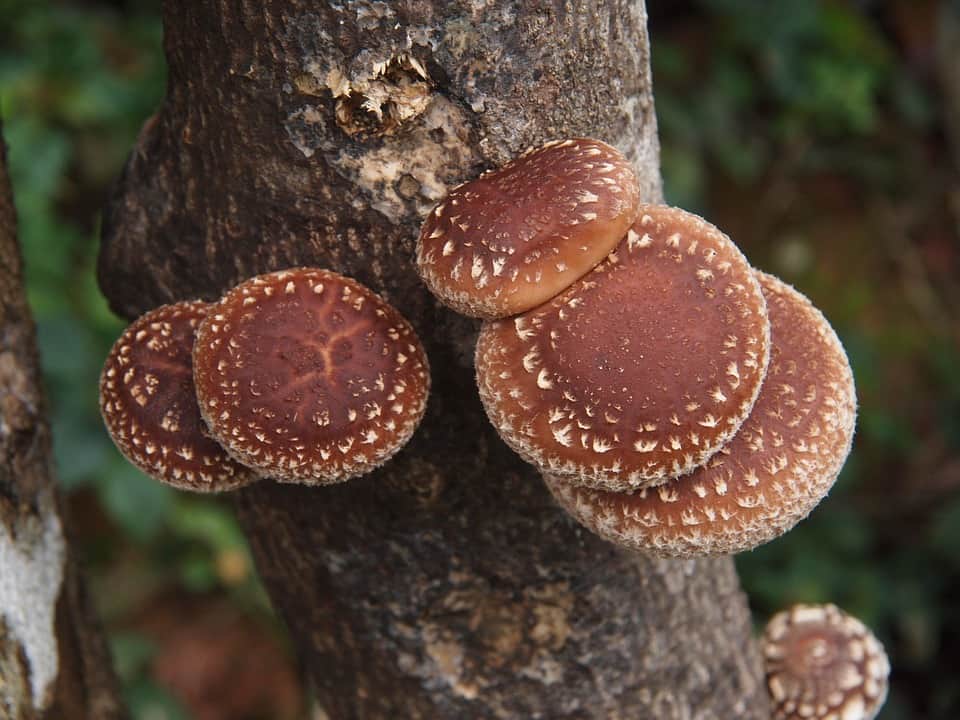
Shiitake Naturally Growing on Hardwood Logs.
The Masters Mix
If you’re looking for an extremely effective substrate for growing oysters, you might want to try what’s know as the Master’s Mix – a 50/50 mix of sawdust and soyhulls, sterilized at 15 PSI for 2.5 hours.
The original “master” behind this mix is T.R. Davis from Earth Angel Mushrooms. You will not likely find any another substrate that will yield as much on the first flush as this mix.
There are two downsides to using soy hulls as far as I can tell. Firstly, the second flush will not be anywhere nearly as strong as the first flush, even though the huge first flush definitely makes up for it.
Secondly, the mix doesn’t seem to colonize as fast as the more traditional supplemented sawdust formula. It’s possible that this is only in my experience, so your miles may vary.
Growing Mushrooms on Manure
Most people think that mushrooms grow on manure- which is indeed true. Although most gourmet species prefer hardwood sawdust or straw, there are many common species that grow best on manure.
Agaricus species, such as the common button mushroom and the portobella mushroom, as well as many Psilocybin species, are good examples.
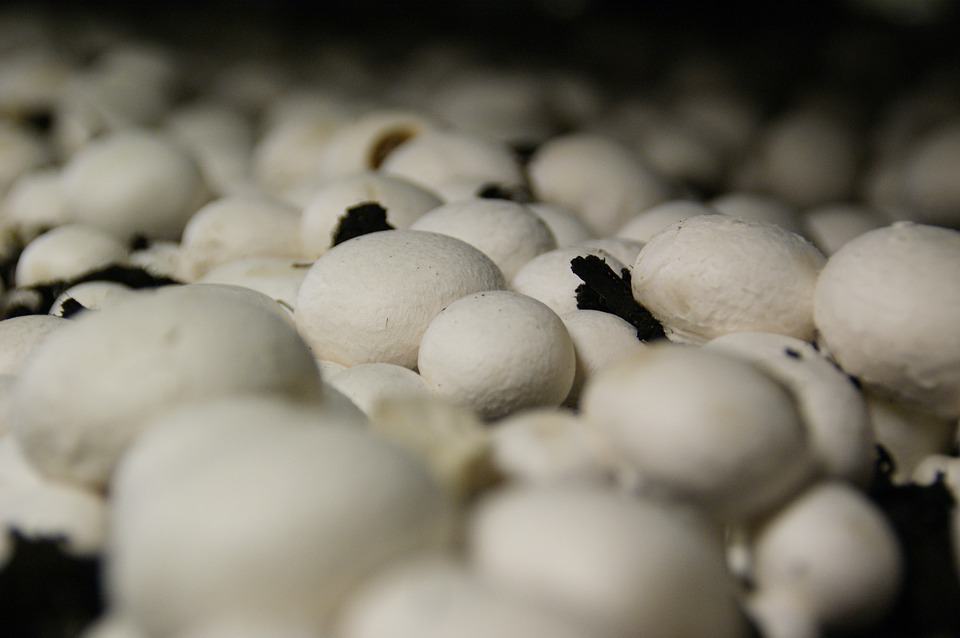
In commercial Agaricus bisporus cultivation, the manure substrate first goes through a multiday composting phase, where large piles of compost (manure and straw) naturally heat up to 160 deg F, and beneficial organisms proliferate.
Once this process is complete, the compost is properly pasteurized to remove all unwanted contaminants. This secondary pasteurization process also removes ammonia that naturally builds up during the first phase compost. Check out this neat video below that sums up the process of preparing compost for button mushroom cultivation:
Growing mushrooms on compost in this manner is usually not pursued by the home grower, though it is certainly possible.
Growing Mushrooms on Coco-Coir
Another common material used to grow mushrooms at home is coco-coir. Coco-coir is a natural material made from the husk and the shell of coconuts.
It is commonly used for quasi-hydroponic plant growing systems. It does a good job of retaining water, and although it doesn’t provide many nutrients for plants, it is reasonably nutritious enough for growing mushrooms, although not so much so that contaminates easily proliferate.
Coco coir is often mixed in a 1:1 ratio with vermiculite to form a suitable mushroom substrate. Vermiculite is an expanded mineral that provides structure to the substrate and retains water, though it is nutritionally inert. The coco-coir vermiculite mix still needs to be properly pasteurized before being inoculated with mushroom grain spawn.
You can buy compressed blocks of coco-coir on Amazon, and can also usually find it at your local garden center. The coco-coir will expand many times it’s size once it is broken apart and soaked with water.
Growing Mushrooms on Coffee
Although it is possible to use nothing but spent coffee grounds as a mushroom growing substrate, it is usually not the best choice. Coffee grounds are high in nitrogen, which provides plenty of energy for the mycelium and helps produce higher yields. This richness of the straight coffee substrates however, make for higher chances of contamination.
Coffee grounds are better used as a supplement added to other substrate materials, such as hardwood sawdust or coco-coir. Coffee grounds should be fully sterilized before being added to the substrate, but you can often get away with just pasteurization.
Uses for Spent Mushroom Substrate
If you start to grow a lot of mushrooms, you might soon end up with large piles of spent substrate that you don’t know what to do with. The shear volume of substrate can add up really quick- so it’s good to have some idea of what to do with it all.
The most obvious choice, if you have a reasonably small amount of spent substrate, is to compost it. Just leave your substrate in a pile outside and let the natural process of decomposition take hold. Chances are good that you might even get an extra flush or two of mushrooms in your compost pile! It doesn’t take long before your spent substrate will decompose into a rich loamy compost that can be added to your vegetable garden.
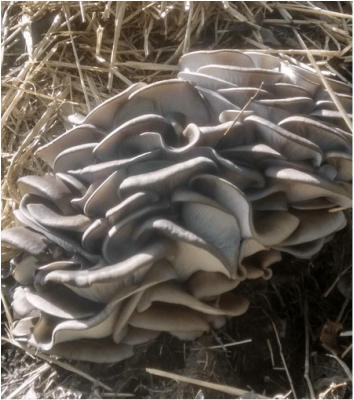
It is also possible that substrate can be reused to grow more mushrooms. For example, if you have a bunch of spent shiitake blocks, you might be able to break them up, re-sterilize them and reuse the organic material to grow more shiitake! Keep in mind though, you will likely need to add supplementation, and you are likely to have yields with diminishing returns.
If you have more spent substrate then you know what to do with, see if your city has a free composting program, or if a nearby farmer is willing to let you start a large compost pile on their land.
Many large commercial mushroom farming operations actually process and sell their spent mushroom substrate as branded compost for gardens.
Learn What Works for You
At the end of the day, what substrate is best for you will depend on your location, style of growing and type of mushrooms you want to grow.
The best way to learn is to experiment with different types of substrates, different methods of preparation and different types of supplementation.
Good luck!
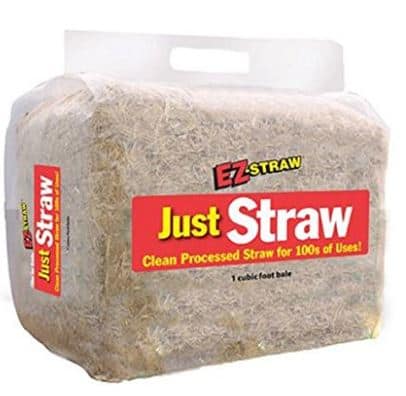
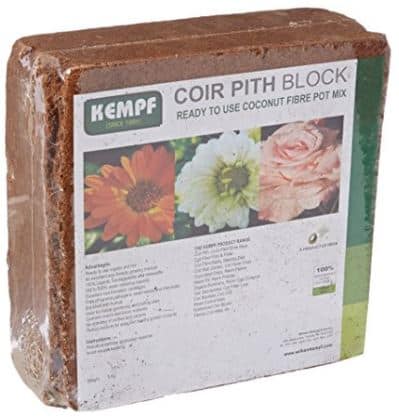
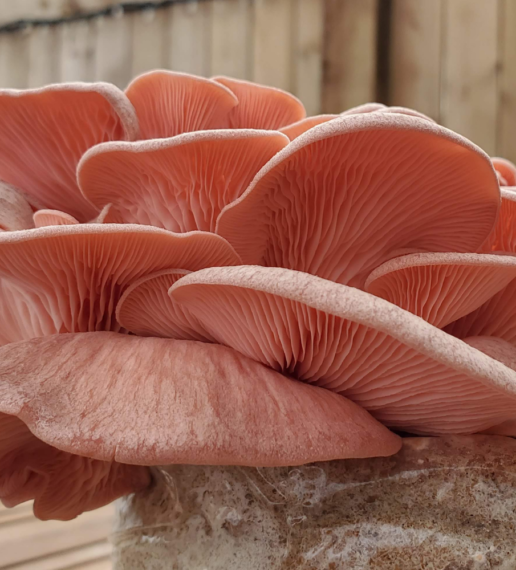
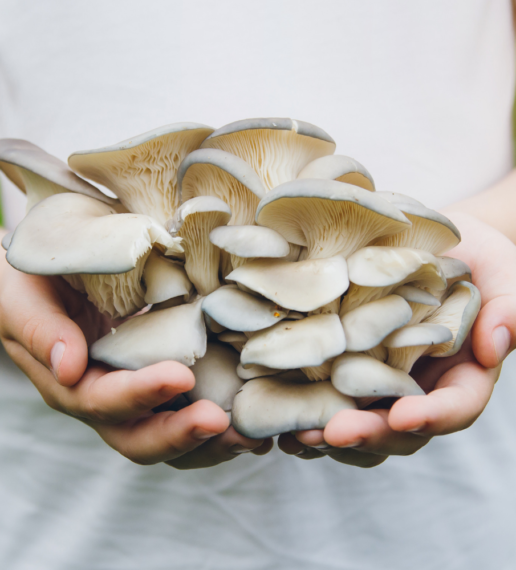
A comprehensive write up. You did not mention paper and cardboard. Mushroom can be used to recycle paper and get some mushroom from paper that are thrown away and their are paper in every home and used cartoon. I have used paper once and And i have a lot of success. Thank you so much for the information
Hey there, thanks for reaching out! Yes, you are right, I did not mention cardboard and paper- a waste product that can make a great substrate!. I am happy that it has worked for you!
In Ireland we have found that PEAT make a wonderful Substrate for mushroom Growth. Have you used Peat?
Hey Patrick!
I have never tried to use peat as a substrate… but I have used it as a casing layer with a bit of hydrated lime. Never thought to use it as a substrate!
Spent mushrooms substrate can be added to the feed of cows , goats and pigs up to 30% of the feed formular. It can also be use in vermiculture ( cultivation of earthworm) as a substitute to fish meal in animal Feed.
Very good points, thanks for posting!
First of all, thank you for this great website. It is really helpful to set up a small scale low tech mushroom farm as I’m willing to do.
Regarding pasteurization, you don’t write anything about cold pasteurization using lime bath.
Have you ever tried ? If so, what are your advises ?
Hey Oliver, I am glad you like the site! No, I haven’t had much experience with cold pasteurization to be honest, but I have heard of many growers using it with success. I will have to start experimenting with it soon!
Hi Tony,
I experimented yesterday the lime bath treatment on straw for P. ostreatus culture… I’ll give you my feedback in few weeks if it worth it.
Thanks Tony, so very please with all the advise but I have to keep calm before I embark on the renewal of my mushroom growing on substrate. I have just acquired a pile of fresh oak logs from my garden, I got the shetake impregnated dowles two days ago I have the every thing ready except for time.
hi sir.. thank you for your information. may i know the minimum amount(volume) of substrate which mushroom can grow on it. because i would like to conduct a treatment test on the substrate which require small amount(volume) of substrate n cultivate the mushroom on the treated substrate.
Hey Shakir,
Thanks for reaching out! I have not conducted any tests on the minimum amount of substrate for a viable grow. It could be worth trying out though. I know mushrooms will fruit on petri dishes, which is obviously a very small amount of substrate, although they don’t develop into full mushrooms.
thank your sir for your reply
Is there any reason it can’t be fed to sheep ?
I have heard of people doing this! It’s a good idea!
I am just beginning to grow mushrooms at home, using a mix of cardboard and coffee grounds. I was wondering if you have any idea what the lifespan of mycelium is? Is it possible to continually add more food to a substrate and receive continuous flushes? Almost like feeding a sourdough starter.
Hey there!
Not sure about this. Generally, if you just leave a fruiting block or straw log after the initial harvest, you will get 2-3 subsequent flushes, after which the mycelium has run its course and it’s time to start over. The best way to save mycelium is using a culture plate or slant, and saev it in the fridge. In that way, you can add the culture to fresh substrate, rather than adding fresh substrate to the mycelium.
Hope that helps!
I was wondering the same thing. I have had a starter dough going for about a year now, and would love to be able to keep a mushroom colony to go along with it. Have you had any success keeping a viable mycelium colony alive and thriving? I would imagine that you would have to do kind of the opposite feeding the mycelium as far as adding spent mushroom block to fresh substrate, as opposed to adding fresh flour and water to the sourdough starter.
Hey tony thanks for your write ups and information , I am opening a mushroom farm in the eastern towships in Quebec, I find your advice both helpful and inspiring .
Keep up the great work
Townships 🙂 not towships
Tony,been reading alot of your articles very informative! My question is( may have overlooked it) but I see alot on wheat bran and oat bran where can you find this at?I have some Lions mane on the way and was wanting to get prepared.
Hey Tim! Glad you like the site 🙂
Oat bran and wheat bran can usually be found at feed stores ( for horses ect.) If you can’t find it there, you should be able to get some at your local grocer.
Hope that helps!
Tony
Hello sir, is it possible to use pure ricebran as a substrate
Hey There!
No, I think pure rice bran would be way to nutrient rich to use as a standalone substrate. Try adding it to sawdust @ around 5% for an effective mix!
Hey Tony,
Awesome information you got here, am just a starter in growing mushrooms, but am trying to use corn curbs as my substrate which I have grounded into saw dust size can I use this alone to grow my mushrooms? And is it possible to add some powdered egg shell to it to increase the calcium contents?
Glad you like the site! Corn cobs should work, for oysters at least. And yes, adding egg shells will be just fine. Happy growing!
hi,
Nice to read ur posting! thanks too that you keep talking back, sharing experiences. i wonder if you have tried dry maize stalk and cob corn…
two how strong do you press or should one press the coco coir for best results?
john
Hey John! yes, press done the coco-coir rather firmly, but it doesn’t need to be packed down extremely tight. The mycelium will bind it together as it grows.
Hi! How much water should i put in my drum to achieve 7-8 hour sterilization??.. also how strong should my fire be?
can inoculated grain spawn be used to inoculate jars to make more grain spawm
Absolutely! Eventually, you will no longer be able to expand it though, as mycelium can only run so far.
Hi Tony,
Would there be any advantage to using straw and coffee grounds as a substrate…. or just stick with straw?
Hey Shannon! I would just stick with straw to be honest. Coffee can be used as a supplementation, but it might cause more issues than it is worth.
Can I use same substrate which is already used before for next cultivation? Thanks!
No, you are definitely best to start with fresh substrate. I’m sure it is possible, perhaps especially if you change species, but probably not worth the effort.
in case we dont have soybean hull pellets can we use soybean meal instead?
Hey Kirby! Can’t say for sure… but definitely worth a try.
Hi! I haven’t found good information about particle sizes for the substrate. If it is sawdust, how small? if it’s another substrate, how big? lets say wood chips. Do you have information about it? or a good source where I can find it?
BEst,
Think chainsaw dust not sanding dust.
You can mix fine sawdust and wood chips/shavings.
Can Alpha Alpha be used as a substrate or is it too rich in nutrients ?
Hey Mark! It’s hard to say… for Oysters it’s likely, although I haven’t tried it. Probably not ideal though…
Can rabbit food pellets be used as a substrate?
thankyou very much Mr stark
I’m looking to do a bulk indoor grow with the least amount of sterilization. Have you ever added pasteurized straw to sterilized bran? I’m thinking of trying this and would like to know if mixing these methods will be more work than it’s work. cheers
What about softwood pellets? I only ever see reference to pellets of hardwood but softwood pellets are much more accessible to me.
I just asked the same question and still trying to find out if you can mix hardwood sawdust with softwood sawdust.
Soft wood is not recommended. Think of the thickness or hardness as an indicator to how much nutrient is in that piece of bark. The denser the better
The trick is understanding what type of wood the mushrooms you are trying to grow perform best on typically. There are charts and matrix available online to see all mushroom and wood type matches.
The reason for more hardwood references is simply due to the vast majority of gourmet mushrooms preferring hardwood. Phoenix Oyster and Turkey Tail are two of the few that prefer softwood.
Tony, thanks for the great substrate detail. Can I pasteurize Straw in a SEALED ziplock, or does it have to leach in open water? I would like to use my souse vide to control the exact temperature, and I sure wouldn’t be upset if I could eliminate the mess of the open water process. Also have to assume straw circulating in open water using the souse vide would ruin the unit sooner or later.
I have done this with sealed bags of hpoo and it has worked great. Excellent yields and additional flushes.
Anyone else have experience with this?
So, I have a bunch of jars I inoculated a 3-4 weeks ago. They finally grew over and as I was building my laminar, and basement to handle growth, they started to pin and fruit a little. Is it too late to break it up and add it to a monotub ?? or do i have to fruit it and clone? is it too late? Also… I have some oysters and shittaki that are in there second flush (third actually for the oysters) . My questions is , can I break up a chunk , add it to a jar and grow off of it ?
Second Question is . I have access to Hardwood sawdust, but not soyhull pellets . I have access to Coco coir too( iv tried for a while now, nobody in my area has it, and I dont want to order because Im developing a local sustainable practice. Can I use coco and sawdust mixed?? or how about rice hulls and sawdust? rice hulls and coco coir ?
THANKS !
Love your articles and YouTube channel!!
Just wondering what mushroom species are suited to the coir/vermiculite substrate? Are certain types just not going to like that substrate mix?
Tony,
Hi. I’m a first time oyster mushroom grower from Durban south Africa. You articles are very impressive.
I hve bought a bale of wheat straw and a bale of lucerne. Also bought wheat bran 5 kg
Can u help with a suggested ratio substrate mix using these three products. Your assistance will be greatly appreciated.
Thanks
Really helpful article, thank you. I have a question please. Just starting off on the mushroom growing adventure 🙂 Can I grow Oysters (Grey, I believe) on woodchip only? It is mostly Willow that I chipped myself.
Hey. How good is using rice husk as substrate.
Hello! Wondering if it is possible to use an Instapot rather than a pressure cooker during the sterilization process?
Thanks 🙂
Yep! I use that and it works great.
Hey Tony thanks for the great work…..
I want to know if you can use sugar cane bagasse as a supplement to hardwood sawdust…and if so does the same sterilization process apply.
Will it be more likely to contaminate….
Hi Tony, say in recently attempted to grow Reishi for the first time. But, I found the grain spawn hard as a brick after colonization. I wasn’t able to break it apart to inoculate sawdust or logs. So in defeat I put the blocks outside in my compost box and covered them with the sawdust blocks I had already pasteurized. To my complete amazement and delight I now have Reishi growing in my compost box! I watched your video of how to make a Reishi tent/green house. But, I am still wondering how does one break up the colonized grain Spohn without contaminating it? It’s way too hard to break up with my hands inside the bag. Thanks Tony you’re amazing and my very favorite teacher!!
Substrate
How well does work the coco coir as substrate in terms of productivity, of species such as h. erinaceus and p. ostreatus?
My substrate came in a tightly packed bag how do I prep this stuff for inoculation???
Do I need to sterilize substrate of compost/manure for growing white button mushrooms?
Hey there! Button mushroom substrate is put through a very specific composting process. Not sterilized, but heat treated.
I tried coffee ground,coffee hull and straw mix as substrate and the mycelium covered well but during the fruiting time it grew and dried I have put water, and moisture in the room does this happen?
Hi Tony,
I like your movies on YouTube and started during COVID times also myself as a hobbyist to grow mushrooms. Unfortunately in France, where I live, you cannot find many people that sell grain spawn and even less that sell good mushroom liquid cultures. Do you have any idea where I can buy good mushroom liquid cultures in France or that can be shipped to France ? Same thing for soy hulls. This is something I really cannot find here in France. Any idea how to get it ?
I want to make 200 grams of rye grain spawn. Do I measure out 200 grams of rye grain, soak it and cook it and then sterilize it to get the desired weight or does the water add to the weight?
Thanks for this very important info. But there is also use of bagasse as substrate could you kindly shade some light on how to prepare sugarcane bagasse as substrate for Reishi? Thanks in.advance
I am interested in mushroom farming.My interest is the percentage of each substrate to 300grams of spawn.Thank you.
I was curious if mixing a couple methods would be successful. I have used coco/verm mix, but was wondering if you could add in hardwood bedding & chicken manure. If sterilized properly, would that work? Or is it one or the other only?